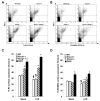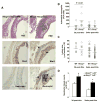Increased inflammatory gene expression in ABC transporter-deficient macrophages: free cholesterol accumulation, increased signaling via toll-like receptors, and neutrophil infiltration of atherosclerotic lesions
- PMID: 18852364
- PMCID: PMC2756536
- DOI: 10.1161/CIRCULATIONAHA.108.793869
Increased inflammatory gene expression in ABC transporter-deficient macrophages: free cholesterol accumulation, increased signaling via toll-like receptors, and neutrophil infiltration of atherosclerotic lesions
Abstract
Background: Two macrophage ABC transporters, ABCA1 and ABCG1, have a major role in promoting cholesterol efflux from macrophages. Peritoneal macrophages deficient in ABCA1, ABCG1, or both show enhanced expression of inflammatory and chemokine genes. This study was undertaken to elucidate the mechanisms and consequences of enhanced inflammatory gene expression in ABC transporter-deficient macrophages.
Methods and results: Basal and lipopolysaccharide-stimulated thioglycollate-elicited peritoneal macrophages showed increased inflammatory gene expression in the order Abca1(-/-)Abcg1(-/-)>Abcg1(-/-)>Abca1(-/-)>wild-type. The increased inflammatory gene expression was abolished in macrophages deficient in Toll-like receptor 4 (TLR4) or MyD88/TRIF. TLR4 cell surface concentration was increased in Abca1(-/-)Abcg1(-/-)>Abcg1(-/-)> Abca1(-/-)> wild-type macrophages. Treatment of transporter-deficient cells with cyclodextrin reduced and cholesterol-cyclodextrin loading increased inflammatory gene expression. Abca1(-/-)Abcg1(-) bone marrow-derived macrophages showed enhanced inflammatory gene responses to TLR2, TLR3, and TLR4 ligands. To assess in vivo relevance, we injected intraperitoneally thioglycollate in Abcg1(-/-) bone marrow-transplanted, Western diet-fed, Ldlr-deficient mice. This resulted in a profound inflammatory infiltrate in the adventitia and necrotic core region of atherosclerotic lesions, consisting primarily of neutrophils.
Conclusions: The results suggest that high-density lipoprotein and apolipoprotein A-1 exert anti-inflammatory effects by promoting cholesterol efflux via ABCG1 and ABCA1 with consequent attenuation of signaling via Toll-like receptors. In response to a peripheral inflammatory stimulus, atherosclerotic lesions containing Abcg1(-/-) macrophages experience an inflammatory "echo," suggesting a possible mechanism of plaque destabilization in subjects with low high-density lipoprotein levels.
Conflict of interest statement
Figures







Similar articles
-
Activation of liver X receptor decreases atherosclerosis in Ldlr⁻/⁻ mice in the absence of ATP-binding cassette transporters A1 and G1 in myeloid cells.Arterioscler Thromb Vasc Biol. 2014 Feb;34(2):279-84. doi: 10.1161/ATVBAHA.113.302781. Epub 2013 Dec 5. Arterioscler Thromb Vasc Biol. 2014. PMID: 24311381 Free PMC article.
-
Deficiency of ATP-binding cassette transporters A1 and G1 in macrophages increases inflammation and accelerates atherosclerosis in mice.Circ Res. 2013 May 24;112(11):1456-65. doi: 10.1161/CIRCRESAHA.113.301086. Epub 2013 Apr 9. Circ Res. 2013. PMID: 23572498 Free PMC article.
-
Genetic deletion of low density lipoprotein receptor impairs sterol-induced mouse macrophage ABCA1 expression. A new SREBP1-dependent mechanism.J Biol Chem. 2008 Jan 25;283(4):2129-38. doi: 10.1074/jbc.M706636200. Epub 2007 Nov 20. J Biol Chem. 2008. PMID: 18029360
-
ATP-binding cassette transporters A1 and G1, HDL metabolism, cholesterol efflux, and inflammation: important targets for the treatment of atherosclerosis.Curr Drug Targets. 2011 May;12(5):647-60. doi: 10.2174/138945011795378522. Curr Drug Targets. 2011. PMID: 21039336 Review.
-
Role of HDL, ABCA1, and ABCG1 transporters in cholesterol efflux and immune responses.Arterioscler Thromb Vasc Biol. 2010 Feb;30(2):139-43. doi: 10.1161/ATVBAHA.108.179283. Epub 2009 Oct 1. Arterioscler Thromb Vasc Biol. 2010. PMID: 19797709 Free PMC article. Review.
Cited by
-
Polymorphonuclear neutrophils and instability of the atherosclerotic plaque: a causative role?Inflamm Res. 2013 Jun;62(6):537-50. doi: 10.1007/s00011-013-0617-0. Epub 2013 Apr 3. Inflamm Res. 2013. PMID: 23549741 Review.
-
MicroRNA-mediated mechanisms of the cellular stress response in atherosclerosis.Nat Rev Cardiol. 2015 Jun;12(6):361-74. doi: 10.1038/nrcardio.2015.38. Epub 2015 Apr 7. Nat Rev Cardiol. 2015. PMID: 25855604 Review.
-
Impact of Cholesterol Metabolism in Immune Cell Function and Atherosclerosis.Nutrients. 2020 Jul 7;12(7):2021. doi: 10.3390/nu12072021. Nutrients. 2020. PMID: 32645995 Free PMC article. Review.
-
PHLPP1 promotes neutral lipid accumulation through AMPK/ChREBP-dependent lipid uptake and fatty acid synthesis pathways.iScience. 2022 Jan 12;25(2):103766. doi: 10.1016/j.isci.2022.103766. eCollection 2022 Feb 18. iScience. 2022. PMID: 35141506 Free PMC article.
-
The Interconnection Between Immuno-Metabolism, Diabetes, and CKD.Curr Diab Rep. 2019 Mar 19;19(5):21. doi: 10.1007/s11892-019-1143-4. Curr Diab Rep. 2019. PMID: 30888513 Review.
References
-
- Gordon DJ, Rifkind BM. High-density lipoprotein-the clinical implications of recent studies. N Engl J Med. 1989;321:1311–1316. - PubMed
-
- Okamoto H, Yonemori F, Wakitani K, Minowa T, Maeda K, Shinkai H. A cholesteryl ester transfer protein inhibitor attenuates atherosclerosis in rabbits. Nature. 2000;406:203–207. - PubMed
-
- Kontush A, Chapman MJ. Functionally defective high-density lipoprotein: a new therapeutic target at the crossroads of dyslipidemia, inflammation, and atherosclerosis. Pharmacol Rev. 2006;58:342–374. - PubMed
-
- Oram JF, Lawn RM, Garvin MR, Wade DP. ABCA1 is the cAMP- inducible apolipoprotein receptor that mediates cholesterol secretion from macrophages. J Biol Chem. 2000;275:34508–34511. - PubMed
Publication types
MeSH terms
Substances
Grants and funding
LinkOut - more resources
Full Text Sources
Other Literature Sources
Medical
Molecular Biology Databases

